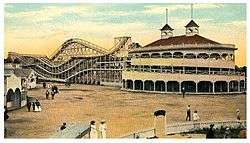Backety-Back Scenic Railway
| Backety-Back Scenic Railway | |
|---|---|
 | |
| Crystal Beach, Ontario | |
| Coordinates | 42°52′03″N 79°03′33″W / 42.8675000°N 079.0591667°WCoordinates: 42°52′03″N 79°03′33″W / 42.8675000°N 079.0591667°W |
| Status | Closed |
| Opening date | 1909 |
| Closing date | 1926 |
| Cost | $50,000 |
| General statistics | |
| Type | Wood – Shuttle |
| Designer | John H. Brown |
| Speed | 10 mph (16 km/h) |
| Inversions | 0 |
| Trains | 2 cars. Riders are arranged 2 across in 5 rows for a total of 20 riders per train. |
|
Backety-Back Scenic Railway at RCDB Pictures of Backety-Back Scenic Railway at RCDB | |
The Backety-Back Scenic Railway was a wooden roller coaster which operated at Crystal Beach, Ontario, from 1909 until 1926.[1] The Backety-Back Scenic Railway was notable for a backward-traveling innovation which would be adopted many years later in more modern steel roller coasters.[2] It was also one of the earliest shuttle roller coasters to be built,[3] as well as being the second roller coaster to be built in the Crystal Beach amusement park.[4] The coaster has been cited as a particularly beautiful example of roller coaster architecture.[5]
History
Backety-Back Scenic Railway was built in 1909 by Pennsylvanian John H. Brown and construction of the coaster cost $50,000.[6] Backety-Back Scenic Railway was the only roller coaster Brown would ever build.[7] In 1904, however, he patented the unique track-reversal design which made the coaster a predecessor to modern shuttle roller coasters.[8]
Track layout and ride experience
Being a shuttle roller coaster, Backety-Back Scenic Railway traveled over its course both forwards and backwards. The coaster had two lift hills and also necessitated the operation of a switchman when the coaster had reached the end of its forward progress.[6] Following this reversal, the train would engage a second reversal and continue on its way.[8] The course of the roller coaster was a twister layout[9] and the roller coaster had a curved tunnel in its course as well.[6] Trains had 2 cars of 5 rows apiece, with each row having two riders.[8]
The coaster had a large station which resembled a riverboat in shape. Inside this station was a ticket office (tickets were sold for 10 cents) and the queue for the ride itself.[8]
Incidents
In 1910, a 17-year-old girl, Louise Koch was killed after falling from the Backety-Back Scenic Railway.[9] The coaster had minimal safety features, and the only restraints were the sides of the cars themselves.[8]
References
- ↑ Marden, Duane. "Backety-Back Scenic Railway (Crystal Beach)". Roller Coaster DataBase. Retrieved August 9, 2013.
- ↑ Francis, David W.; Francis, Diane DeMali (2003). The Golden Age of Roller Coasters. Arcadia Publishing. ISBN 0738523380. Retrieved August 9, 2013.
- ↑ Marden, Duane. "List of shuttle roller coasters". Roller Coaster DataBase. Retrieved 9 August 2013.
- ↑ Marden, Duane. "Crystal Beach". Roller Coaster DataBase. Retrieved August 9, 2013.
- ↑ Cartmell, Robert (1987). The Incredible Scream Machine: A History of the Roller Coaster. Popular Press. ISBN 0879723424. Retrieved August 9, 2013.
- 1 2 3 Hirsch, Rose Ann (2011). Western New York Amusement Parks. Arcadia Publishing. ISBN 0738574562. Retrieved August 9, 2013.
- ↑ Marden, Duane. "List of John H. Brown roller coasters". Roller Coaster DataBase. Retrieved August 9, 2013.
- 1 2 3 4 5 "Crystal Beach Park (1888-1989)". Closed Canadian Parks. Coaster Enthusiasts of Canada. Retrieved August 9, 2013.
- 1 2 Rossi, Erno (2005). Crystal Beach: The Good Old Days. Seventy Seven Publishing. ISBN 0920926045. Retrieved August 9, 2013.